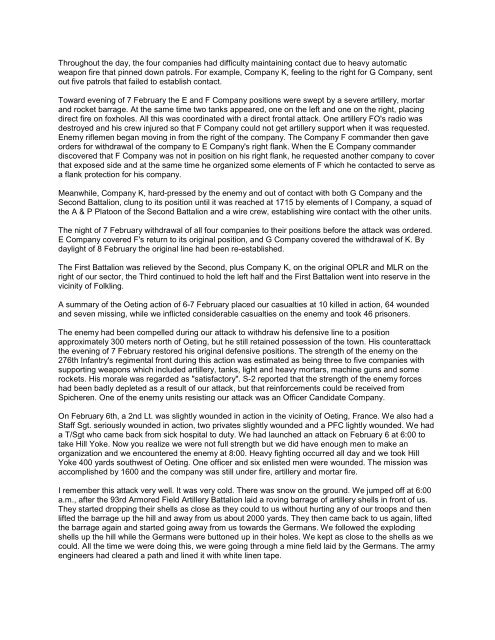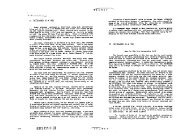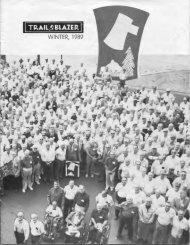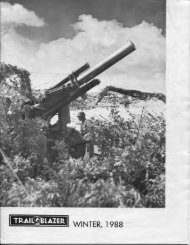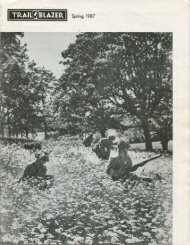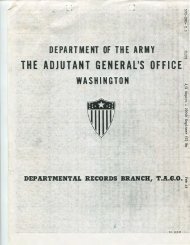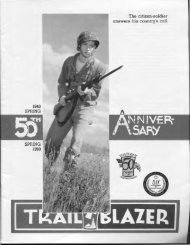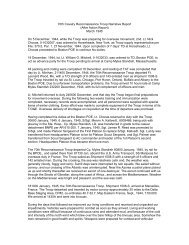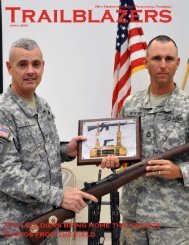Download - 70th Infantry Division Association
Download - 70th Infantry Division Association
Download - 70th Infantry Division Association
You also want an ePaper? Increase the reach of your titles
YUMPU automatically turns print PDFs into web optimized ePapers that Google loves.
Throughout the day, the four companies had difficulty maintaining contact due to heavy automatic<br />
weapon fire that pinned down patrols. For example, Company K, feeling to the right for G Company, sent<br />
out five patrols that failed to establish contact.<br />
Toward evening of 7 February the E and F Company positions were swept by a severe artillery, mortar<br />
and rocket barrage. At the same time two tanks appeared, one on the left and one on the right, placing<br />
direct fire on foxholes. All this was coordinated with a direct frontal attack. One artillery FO's radio was<br />
destroyed and his crew injured so that F Company could not get artillery support when it was requested.<br />
Enemy riflemen began moving in from the right of the company. The Company F commander then gave<br />
orders for withdrawal of the company to E Company's right flank. When the E Company commander<br />
discovered that F Company was not in position on his right flank, he requested another company to cover<br />
that exposed side and at the same time he organized some elements of F which he contacted to serve as<br />
a flank protection for his company.<br />
Meanwhile, Company K, hard-pressed by the enemy and out of contact with both G Company and the<br />
Second Battalion, clung to its position until it was reached at 1715 by elements of I Company, a squad of<br />
the A & P Platoon of the Second Battalion and a wire crew, establishing wire contact with the other units.<br />
The night of 7 February withdrawal of all four companies to their positions before the attack was ordered.<br />
E Company covered F's return to its original position, and G Company covered the withdrawal of K. By<br />
daylight of 8 February the original line had been re-established.<br />
The First Battalion was relieved by the Second, plus Company K, on the original OPLR and MLR on the<br />
right of our sector, the Third continued to hold the left half and the First Battalion went into reserve in the<br />
vicinity of Folkling.<br />
A summary of the Oeting action of 6-7 February placed our casualties at 10 killed in action, 64 wounded<br />
and seven missing, while we inflicted considerable casualties on the enemy and took 46 prisoners.<br />
The enemy had been compelled during our attack to withdraw his defensive line to a position<br />
approximately 300 meters north of Oeting, but he still retained possession of the town. His counterattack<br />
the evening of 7 February restored his original defensive positions. The strength of the enemy on the<br />
276th <strong>Infantry</strong>'s regimental front during this action was estimated as being three to five companies with<br />
supporting weapons which included artillery, tanks, light and heavy mortars, machine guns and some<br />
rockets. His morale was regarded as "satisfactory". S-2 reported that the strength of the enemy forces<br />
had been badly depleted as a result of our attack, but that reinforcements could be received from<br />
Spicheren. One of the enemy units resisting our attack was an Officer Candidate Company.<br />
On February 6th, a 2nd Lt. was slightly wounded in action in the vicinity of Oeting, France. We also had a<br />
Staff Sgt. seriously wounded in action, two privates slightly wounded and a PFC lightly wounded. We had<br />
a T/Sgt who came back from sick hospital to duty. We had launched an attack on February 6 at 6:00 to<br />
take Hill Yoke. Now you realize we were not full strength but we did have enough men to make an<br />
organization and we encountered the enemy at 8:00. Heavy fighting occurred all day and we took Hill<br />
Yoke 400 yards southwest of Oeting. One officer and six enlisted men were wounded. The mission was<br />
accomplished by 1600 and the company was still under fire, artillery and mortar fire.<br />
I remember this attack very well. It was very cold. There was snow on the ground. We jumped off at 6:00<br />
a.m., after the 93rd Armored Field Artillery Battalion laid a roving barrage of artillery shells in front of us.<br />
They started dropping their shells as close as they could to us without hurting any of our troops and then<br />
lifted the barrage up the hill and away from us about 2000 yards. They then came back to us again, lifted<br />
the barrage again and started going away from us towards the Germans. We followed the exploding<br />
shells up the hill while the Germans were buttoned up in their holes. We kept as close to the shells as we<br />
could. All the time we were doing this, we were going through a mine field laid by the Germans. The army<br />
engineers had cleared a path and lined it with white linen tape.


